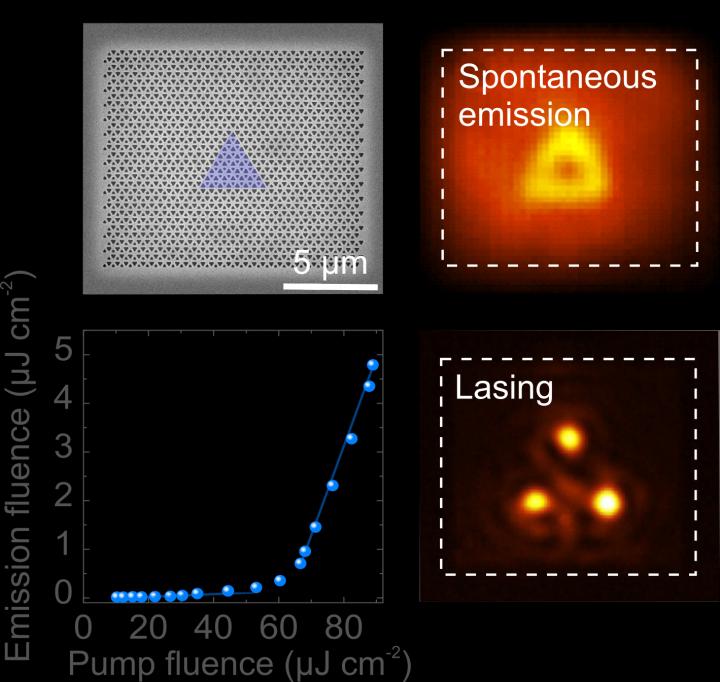Valley-Hall nanoscale lasers

a Scanning electron microscope image of the fabricated sample. The false-colour triangle marks the interior of the topological cavity. b Emission energy vs. the pump energy dependence showing a threshold transition to lasing. The sample is optically pumped at a 980 nm wavelength with 8 ns pulses at a 10 kHz repetition rate. c, d Spatial distribution of emission for the pump intensity (c) below and (d) above the lasing threshold. Credit by Daria Smirnova, Aditya Tripathi, Sergey Kruk, Min-Soo Hwang, Ha-Reem Kim, Hong-Gyu Park, and Yuri Kivshar
Nanostructures made of high-index dielectric materials with judiciously designed resonant elements and lattice arrangements show special promise for implementation of topological order for light at the nanoscale and optical on-chip applications.
High-index dielectrics such as III-V semiconductors that can contain strong optical gain further enhanced by topological field localization form a promising platform for active topological nanophotonics.
In a new paper published in Light Science & Application, a team of scientists, led by Yuri Kivshar from the Australian National University and Hong-Gyu Park from the Korea University, and co-workers have implemented nanophotonic cavities in a nanopatterned InGaAsP membrane incorporating III-V semiconductor quantum wells.
The nanocavities exhibit a photonic analogue of valley-Hall effect. Researchers demonstrated room-temperature low-threshold lasing from a cavity mode hosted within the topological bandgap of the structure.
The SEM image of the fabricated structure and experimental results are shown in Figure. The cavity is based on the closed valley-Hall domain wall created by inversion of staggering nanoholes sizes in a bipartite honeycomb lattice.
In the topological bandgap frequency range, the cavity supports a quantized spectrum of modes confined to the domain wall. The images show real-space emission profiles below and above the threshold.
The scientists explain:
“In experiment, we first observe spontaneous emission from the cavity. The emission profile shows the enhancement along the entire perimeter of the triangular cavity associated with edge states. When increasing a pump power, we observe a threshold transition to lasing with a narrow-linewidth where the emission gets confined at the three corners.”
When two spots are isolated, coherence of the emission is confirmed by interference fringes observed in the measured far-field radiation patterns. An isolated corner emits a donut-shaped beam carrying a singularity. These findings make a step topologically controlled ultrathin light sources with nontrivial radiation characteristics. The researchers forecast:
“The proposed all-dielectric platform holds promise for the versatile design of active topological metasurfaces with integrated light sources. Such topological nanocavities has vast potential for advances in nonlinear nanophotonics, low-power nanolasing and cavity quantum electrodynamics”.
Media Contact
More Information:
http://dx.doi.org/10.1038/s41377-020-00350-3All latest news from the category: Physics and Astronomy
This area deals with the fundamental laws and building blocks of nature and how they interact, the properties and the behavior of matter, and research into space and time and their structures.
innovations-report provides in-depth reports and articles on subjects such as astrophysics, laser technologies, nuclear, quantum, particle and solid-state physics, nanotechnologies, planetary research and findings (Mars, Venus) and developments related to the Hubble Telescope.
Newest articles

First-of-its-kind study uses remote sensing to monitor plastic debris in rivers and lakes
Remote sensing creates a cost-effective solution to monitoring plastic pollution. A first-of-its-kind study from researchers at the University of Minnesota Twin Cities shows how remote sensing can help monitor and…

Laser-based artificial neuron mimics nerve cell functions at lightning speed
With a processing speed a billion times faster than nature, chip-based laser neuron could help advance AI tasks such as pattern recognition and sequence prediction. Researchers have developed a laser-based…

Optimising the processing of plastic waste
Just one look in the yellow bin reveals a colourful jumble of different types of plastic. However, the purer and more uniform plastic waste is, the easier it is to…


